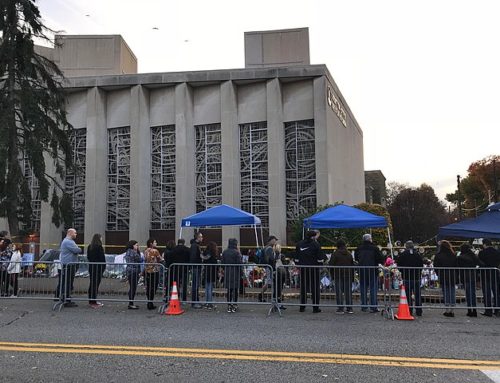Last week, I had the pleasure of listening to Scott Say, the author of Getting Our Groove Back. Mr. Shay articulated rationally the dramatic decline in the number of Jews in America, the negative consequences of this demographic decline both for American Jewry and the United States, and lastly suggested some solutions.
Stated succinctly, the number of Americans who identify as Jews has already dropped significantly. In 1980, there were 5.9 million American Jews, today; there are only 4.3 million Americans who identify themselves as Jews. Furthermore, this number is augmented by the influx of some 500,000 Russian Jewish immigrants who have arrived in the United States since 1990. Stated differently, without the immigration of these 500,000 Russian Jews, the American Jewish population would have dropped to 3.8 million. Moreover, given the high Jewish intermarriage rate, the low fertility rate on Non-orthodox Jews, statisticians estimate that the Jewish population in America will decline to as low as 2.5 million in 2030. In other words, the American Jewish population in 50 years (198—2030) is expected to fall by 3 million.
The author argues that an American Jewish population of 2.5 million people might drop the Jewish population below critical mass. That is, historically for Judaism to survive Judaism requires a large enough community that encourages education, marriage with co-religionists, sustain Jewish philanthropies, Jewish community centers, and other Jewish cultural events. At 2.5 million, the Jewish population might be so dispersed that the remaining Jews except for a few urban centers might assimilate faster than the experience from 1980-2007. Furthermore it is my belief (not articulated by Daniel Shay) that a numerically small American Jewish population could reduce Jewish influence on the American political process, thereby reducing America’s historical pro-Israeli foreign policy.
Why has the American Jewish population declined so precipitously?
Shay argues that the principal reason is that for most Jews (excluding the ultra Orthodox community), Judaism has loss its sense of wholeness and purpose. That is, for a large number of Jews, the future of American Jewry as a whole community is irrelevant.
Shay also specifically mentions that contributing to the decline are the forces of assimilation, high intermarriage rates (some 50 %), low fertility rates and inadequate Jewish education.
Why does Shay feel that the dramatic decline of American Jewry is so worrisome both for Jewry, and the Gentile world?
First of all, American Jews represent 85% of the economic resources of the Jewish Diaspora (Jews living outside of Israel), and 70% of the Jewish population living outside of Israel.
Secondly, Shay and others point out the incredible contributions that American Jews have made to the United States. Shay mentions individuals such as Jonas Salk, Saul Bellow, Aaron Copland, Henry Kissinger, Louis Brandeis, Isaac Stern, Barbara Streisand, Steven Spielberg, Benny Goodman, Samuel Gompers, Isaac Bashevis Singer, George and Ira Gershwin, Richard Rogers, Oscar Hammerstein, Felix Frankfurter, Albert Einstein, Robert Oppenheimer, Woody Allen, and the list goes on and on.
Thirdly, Jewish contribution to Hollywood, the legal and medical profession, the field of music, psychology, sociology, economics, anthropology, the humanities and the business community has been dramatically disproportionate to their population. Of American Nobel Prize winners, 37% have been Jewish Americans (19 times the percentage of Jews in the population.
Lastly, The Manhattan Project, America’s World War II effort to develop the atomic bomb included the contributions of Jewish physicists: Robert Oppenheimer, Edward Teller, Isidor Rabi, Eugene Wigner, Niels Bohr, etc. Stated differently, the atomic and hydrogen bomb could not have been developed without Jews.
Philanthropy
While it is hard to pin down the exact amount of Jewish philanthropy both to Jewish and non-Jewish causes, one can make some reasonable assumptions.
First of all, because of their tradition of giving and their high per capital income relative to the overall population, most experts believe that Jews give a disproportionate amount of money to charity relative to their population.
A majority of American Jews support both Jewish and general causes. Even the largest and most well known “Jewish foundations” fund within the general community as well. Some older, more established foundations have focused on general community funding through the foundation, and dispersed their Jewish philanthropy through a lump sum given to the local Federation, and/or discretionary contributions by the individual family members. This model is changing; however, as a growing number of foundations are beginning to evaluate their Jewish funding in the same way they assess their general funding—as a program area with focused funding priorities.
Stated differently, of the gifts over $10 million dollars given by Jews, only 6% when to Jewish causes. Universities, Hospitals, Museums, etc. were major beneficiaries.
Why is the Jewish population decline in America a somewhat unique threat to the ability of Jews to maintain a critical mass?
Jews throughout the world have experienced anti-Semitism over the past thirty-five hundred years. Nevertheless, despite pogroms and even the holocaust, Jewish life survived. Thus, why is the American experience so disturbing the Shay and others?
First of all, until 1800 Jews in Europe lived in ghettos. Thus, they lived and died as citizens of “Jewish life” rather than the general community. Stated differently, Jews life in the ghetto meant that Jews almost never intermarried carried on a rich Jewish cultural tradition, lived under Jewish law rather than the legal system of the country within which they were residing. Thus, despite many difficulties Jews could maintain their numerical base and their Jewish identity.
Secondly, the holocaust dramatically decimated European Jewry. Furthermore, the establishment of the State of Israel catalyzed the expulsion of Jews from Moslem countries in the Middle East and North Africa. Thus, 70% of Jews living outside of Israel live in the United States. The many of the remaining 30% live in hostile environments such as Argentina, Russia, France, Hungary, and South Africa. Moreover, the Jewish population of Great Britain has undergone a similar decline to the American experience.
Thirdly, the American religious tolerance tradition has facilitated Jewish assimilation. Without physical separation such as walls or family pressures against inter-marriage, Jews have increasingly assimilated into the larger community. This assimilation has also led to a de-emphasis on Jewish education. The proliferation of Holocaust museums and Jewish cultural activities cannot overcome the lack of Jewish education and the discontinuance of Jewish traditions such as celebrating the Sabbath. In essence, many Jews despite their secular education are illiterate Jews.
Fourth, Jewish inter-marriage has led to an alarming decline in Jewish identification. Only 10% of the grandchildren of inter-married Jews identify with the Jewish religion.
Fifth, with the exception of the Ultra-Orthodox community, the number of reform Jews, conservative Jews, and even Orthodox Jews has numerically declined. Only in the Ultra-Orthodox community has Jewish population grown.
Sixth, many traditional religious organizations are suffering numerical declines such as Presbyterians, Episcopalians, and Lutherans. Instead, the growth has taken place among evangelical Christian, Mormons, Moslems, and ultra-Orthodox. Interestingly enough, the American Mormon population has increased about six fold from about 1 million in 1940 to about 6 million today. The Mormons and other evangelical groups have benefited from strong community ties, active conversion efforts, and emphasis on the religious traditions within their households.
In conclusion, Scott Shay argued persuasively that the American Jewish demographic decline has negative ramifications not only for Jewry but the greater community. To what extent, Judaism can reinvent itself to overcome the present challenges remains an open question.
Originally published in the Sarasota Herald-Tribune


